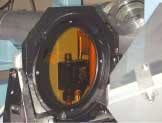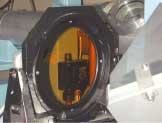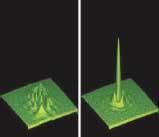Scientists at the Central Laser Facility (CLF) of the Rutherford Appleton Laboratory (Didcot, England) have developed novel adaptive-optic mirrors to steer and improve the beam from the facility's Vulcan laser. An Nd:glass laser, Vulcan was recently named by the Guinness Book of World Records as the highest intensity focused laser in the world, capable of producing a beam with a focused intensity of 1021 W/cm2 (equivalent to all the sunlight falling on the Earth focused onto the end of a human hair).
The adaptive-optic development program in the CLF started nearly 10 years ago, with the aim of developing low-cost deformable mirrors capable of handling laser-beam sizes in the 100- to 150-mm range. These mirrors can compensate for thermal effects in gas- and glass-laser amplifiers, and can correct the cumulative errors of large numbers of optics in the laser chain. For reasons of cost, convenience, and safety, the industry created bimorph-type devices that operate at less than 100 V. These mirrors need correction in the low-frequency range. The mirrors are used in an air-conditioned laser hall. If air turbulence can be minimized, the remaining errors are either static (passive aberrations) or slowly varying (thermal effects in amplifiers), and a correction rate of a few hertz is adequate. After some preliminary tests, a novel construction technique was developed to make large continuous-face bimorph mirrors that can, in principle, be scaled up to very large sizes.
null
A bimorph mirror consists of a glass substrate bonded to a wafer of piezoceramic material, generally lead zirconate titanate, which acts as a piezoelectric transducer (PZT). There is a common electrode between the glass and the PZT, and a set of discrete electrodes on the rear face of the PZT to which control voltages can be applied. The front face of the substrate has a reflective coating. When voltage is applied through the thickness of the PZT, it expands or contracts—attempting to follow the plane parallel to the mirror—along the applied field. Because no movement is possible at the face that is bonded to the glass, the PZT bends, forming a convex or concave curvature depending on the polarity of the applied voltage. The deformation of the mirror face is typically a few microns, and a wide range of shapes can be obtained by varying the combinations of control voltages.
One of the main restrictions on the use of these mirrors is the risk of laser damage to the coating. High-power laser mirrors generally have multilayer dielectric coatings with excellent damage resistance, but such coatings have internal stresses that would cause the thin adaptive mirror to bend unacceptably. Currently, gold or aluminum coatings are used, which do not cause the mirror to bend but are more easily damaged by high laser intensities.
The first mirror made using this technique was 100 mm in diameter, with a 70-mm square of 200-µm-thick PZT on the back surface. An 8 × 8 square array of actuators was printed onto the PZT with conductive ink, and wires were attached to each actuator with conducting paint. The PZTs were under computer control from -64 to +64 V. The wavefront reflected from the mirror was measured with a wavefront sensor, using a CCD camera and frame storing. PZT correction voltages were calculated from the measured wavefront in real time using software developed by the researchers. These were applied to the separate electrodes on the mirror by a 64-channel driver unit.
Mirrors of at least 130-mm diameter are needed to control the 108-mm-diameter beams of the Vulcan laser because the edge of the beam can be controlled only by actuators placed outside the beam. By using a substrate diameter of 150 mm, edge distortion effects can be minimized. There was a problem, however; PZT material of the right thickness was not available in a piece large enough because of the inherent fragility of the ceramic. The initial prototype 150-mm mirror was built using smaller pieces of PZT, each a quarter of the required circle. The small gaps between the quadrants led to the mirror becoming pyramidal, however, because the assembly was more flexible along the lines between the PZT wafers.
A thick PZT disc
For successful wavefront correction, it was essential to use a single piece of ceramic. The CFL team overcame the problems by bonding a much thicker PZT disc (a few millimeters thick) to the substrate, then grinding it down to the required thickness. During grinding, the mirror substrate acts as a support for the PZT, which is relatively easy to grind using conventional optical abrasives. Using this technique, the team has successfully constructed several 150-mm mirrors. The method is in principle limited only by the size of PZT discs that can be obtained, which is currently around 200 mm.
"The mirror corrects the aberrations of the petawatt beam so well that a 60-cm beam can be focused to a 5-µm spot with an ƒ/3.2 off-axis parabola," said Chris Hooker, the leader of the adaptive-optic development team. "This corresponds to just 1.5 times the diffraction limit, which is an excellent performance for such a large laser."
Over the next three years, the team aims to develop larger adaptive mirrors with damage-resistant dielectric coatings as part of a joint research program funded through the European Union "Laserlab-Europe" consortium. The new dielectric adaptive mirrors are intended to be used in a similar manner on the new Astra "Gemini" system, a multimillion-pound dual-beam petawatt laser system to be developed at the CLF.


